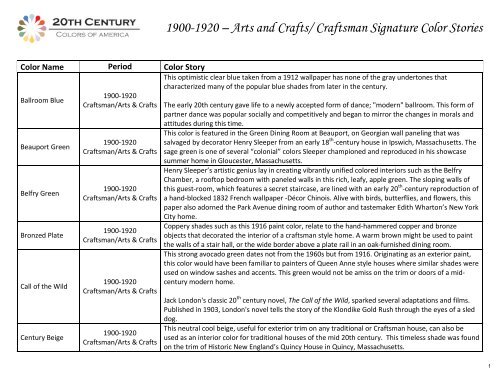Craftsman Signature Color Stories - California Paints
Craftsman Signature Color Stories - California Paints
Craftsman Signature Color Stories - California Paints
Create successful ePaper yourself
Turn your PDF publications into a flip-book with our unique Google optimized e-Paper software.
1900-1920 – Arts and Crafts/ <strong>Craftsman</strong> <strong>Signature</strong> <strong>Color</strong> <strong>Stories</strong><br />
<strong>Color</strong> Name Period <strong>Color</strong> Story<br />
Ballroom Blue<br />
Beauport Green<br />
Belfry Green<br />
Bronzed Plate<br />
Call of the Wild<br />
Century Beige<br />
1900-1920<br />
<strong>Craftsman</strong>/Arts & Crafts<br />
1900-1920<br />
<strong>Craftsman</strong>/Arts & Crafts<br />
1900-1920<br />
<strong>Craftsman</strong>/Arts & Crafts<br />
1900-1920<br />
<strong>Craftsman</strong>/Arts & Crafts<br />
1900-1920<br />
<strong>Craftsman</strong>/Arts & Crafts<br />
1900-1920<br />
<strong>Craftsman</strong>/Arts & Crafts<br />
This optimistic clear blue taken from a 1912 wallpaper has none of the gray undertones that<br />
characterized many of the popular blue shades from later in the century.<br />
The early 20th century gave life to a newly accepted form of dance; "modern" ballroom. This form of<br />
partner dance was popular socially and competitively and began to mirror the changes in morals and<br />
attitudes during this time.<br />
This color is featured in the Green Dining Room at Beauport, on Georgian wall paneling that was<br />
salvaged by decorator Henry Sleeper from an early 18 th -century house in Ipswich, Massachusetts. The<br />
sage green is one of several “colonial” colors Sleeper championed and reproduced in his showcase<br />
summer home in Gloucester, Massachusetts.<br />
Henry Sleeper’s artistic genius lay in creating vibrantly unified colored interiors such as the Belfry<br />
Chamber, a rooftop bedroom with paneled walls in this rich, leafy, apple green. The sloping walls of<br />
this guest-room, which features a secret staircase, are lined with an early 20 th -century reproduction of<br />
a hand-blocked 1832 French wallpaper -Décor Chinois. Alive with birds, butterflies, and flowers, this<br />
paper also adorned the Park Avenue dining room of author and tastemaker Edith Wharton’s New York<br />
City home.<br />
Coppery shades such as this 1916 paint color, relate to the hand-hammered copper and bronze<br />
objects that decorated the interior of a craftsman style home. A warm brown might be used to paint<br />
the walls of a stair hall, or the wide border above a plate rail in an oak-furnished dining room.<br />
This strong avocado green dates not from the 1960s but from 1916. Originating as an exterior paint,<br />
this color would have been familiar to painters of Queen Anne style houses where similar shades were<br />
used on window sashes and accents. This green would not be amiss on the trim or doors of a midcentury<br />
modern home.<br />
Jack London's classic 20 th century novel, The Call of the Wild, sparked several adaptations and films.<br />
Published in 1903, London's novel tells the story of the Klondike Gold Rush through the eyes of a sled<br />
dog.<br />
This neutral cool beige, useful for exterior trim on any traditional or <strong>Craftsman</strong> house, can also be<br />
used as an interior color for traditional houses of the mid 20th century. This timeless shade was found<br />
on the trim of Historic New England’s Quincy House in Quincy, Massachusetts.<br />
1
<strong>Color</strong> Name Period <strong>Color</strong> Story<br />
Clam Shell<br />
Classic Shutter<br />
Combustion<br />
Concord Bloom<br />
Cozy Bungalow<br />
<strong>Craftsman</strong> Gold<br />
Eclectic Trim<br />
Enamel Blue<br />
1900-1920<br />
<strong>Craftsman</strong>/Arts & Crafts<br />
1900-1920<br />
<strong>Craftsman</strong>/Arts & Crafts<br />
1900-1920<br />
<strong>Craftsman</strong>/Arts & Crafts<br />
1900-1920<br />
<strong>Craftsman</strong>/Arts & Crafts<br />
1900-1920<br />
<strong>Craftsman</strong>/Arts & Crafts<br />
1900-1920<br />
<strong>Craftsman</strong>/Arts & Crafts<br />
1900-1920<br />
<strong>Craftsman</strong>/Arts & Crafts<br />
1900-1920<br />
<strong>Craftsman</strong>/Arts & Crafts<br />
This neutral oatmeal color can be found in early 20 th -century wallpapers. At this time, walls often<br />
featured neutral oatmeal, khaki or tan as a base color beneath stenciled border patterns in living and<br />
dining rooms.<br />
Shell textures became one of the popular elements of Art Noveau, a style of art and architecture that<br />
peaked at the start of the 20th century. This design style emphasized organic, floral, and plant inspired<br />
motifs.<br />
This very dark olive green was a classic shutter and sash color on houses from the 1880s through the<br />
1920s. This green was used on the shutters at Historic New England's Beauport house museum, a<br />
1907 summer home and landmark overlooking Massachusetts' historic Gloucester Harbor.<br />
A rich berry red, such as this color found in a 1907 wallpaper, was a staple of a craftsman dining room.<br />
Wine-colored walls in burgundy and claret have been popular for dining rooms since the early 19 th<br />
century.<br />
The widespread refinement and use of the internal combustion engine directly impacted the mass<br />
production of the automobile during the 1910s and 20s, making car ownership more than an<br />
American dream.<br />
Vivid purple, such as this shade found in a 1912 wallpaper border with swags of grapes, provided a<br />
rich accent in arts and crafts interiors. Grapes were a common decorative theme for dining rooms in<br />
the early 1900s.<br />
The terracotta pink in this 1916 paint color was used both inside and outside. A stuccoed bungalow in<br />
the Spanish colonial revival style, or a living room, library, or stair hall would be equally at home with<br />
this warm neutral shade.<br />
This 1916 deep golden oak is an iconic color of the <strong>Craftsman</strong> and Arts and Crafts period. An<br />
appropriate color for exterior siding on a bungalow, this golden shade would also be found in a boldlycolored<br />
craftsman living or dining room.<br />
The exterior trim at Beauport in Gloucester, Massachusetts, is a deep brown - the typical trim color<br />
choice for Tudor revival houses. The home reflects the eclectic tastes of its builder, interior designer<br />
Henry Davis Sleeper. The mix of materials (shingle, brick, and stone) shares many stylistic features<br />
with Tudor revival houses of the same period.<br />
Called Pure Blue in a 1916 paint guide, this shade was intended for outside use on shutters, window<br />
sashes and doors.<br />
During the Arts and Crafts era, the use of highly colored enamel to decorate jewelry was very<br />
common. High end jewelry designers such as Tiffany & Co. stylized this trend during the 1920s.<br />
2
<strong>Color</strong> Name Period <strong>Color</strong> Story<br />
Fahrenheit<br />
1900-1920<br />
<strong>Craftsman</strong>/Arts & Crafts<br />
A 1909 wallpaper provided this deep red-brown typical of the saturated earth tones of the Arts and<br />
Crafts interior. Saturated colors such as this made a comeback in the 1940s and 50s in mid-century<br />
modern wallpapers, upholstery and furnishings.<br />
Ray Bradbury's 1953 novel Fahrenheit 451 focuses on a future America where reading is outlawed.<br />
Some say the book burning theme in the novel criticizes state sponsored censorship while others feel<br />
the book reveals insight to the effect of mass media on literature.<br />
Garden Terrace<br />
Garnet<br />
Glass Art<br />
Green Glass<br />
Guilded Copper<br />
1900-1920<br />
<strong>Craftsman</strong>/Arts & Crafts<br />
1900-1920<br />
<strong>Craftsman</strong>/Arts & Crafts<br />
1900-1920<br />
<strong>Craftsman</strong>/Arts & Crafts<br />
1900-1920<br />
<strong>Craftsman</strong>/Arts & Crafts<br />
1900-1920<br />
<strong>Craftsman</strong>/Arts & Crafts<br />
The Sun Porch at Beauport features a faded blue shade perfect for the quiet glass-enclosed sitting<br />
area that runs along the harbor side of this charming summer home, the life work of innovative<br />
interior designer, Henry Davis Sleeper. The sun porch overlooks a series of garden terraces; carefully<br />
crafted outdoor rooms whose summer plantings were as thoughtfully color-coordinated as the shades<br />
used inside the house.<br />
A dark red, such as this color found in a 1907 wallpaper, was an essential color of the <strong>Craftsman</strong> era.<br />
Rich accents in deep shades of copper, garnet red, olive, and gold enlivened the earth colors and<br />
wood grains of this design movement. Paneling or applied molding often placed with a plate rail<br />
around the top third of the wall, allowed for the space above to be filled by a wallpaper border or<br />
painted in a deep accenting color.<br />
This 1916 exterior paint color would work on an arts and crafts home, but is also the signature siding<br />
color of Historic New England’s Cogswell’s Grant. This 18 th century Essex, Massachusetts summer<br />
home of noted folk art collectors Bertram and Nina Fletcher Little was restored in the late 1930s.<br />
Glass art, from artists like Louis Comfort Tiffany, helped create stained glass home decoratives<br />
inspired by the Arts and Crafts era.<br />
This clear apple-green can be found in the Belfry Chamber, a rooftop guest-bedroom with paneled<br />
green walls located in Historic New England's Beauport property. This unique green has also appeared<br />
in interior settings in everything from kitchen utensils to pedestal sinks in houses across America<br />
through the 1950s. During the Arts and Crafts movement, leaded and stained glass were both popular<br />
materials and can be found at Beauport.<br />
This strong mustard yellow, a 1916 exterior paint, reflects the Arts and Crafts’ fascination with rich<br />
earth tones.<br />
Copper and brass were two of the most popular materials used by artists during the Arts and Crafts<br />
movement. Craftsmen of the time learned their trade through guilds where they began as<br />
apprentices.<br />
3
<strong>Color</strong> Name Period <strong>Color</strong> Story<br />
Guilded White<br />
Heart of Darkness<br />
Ivory Cottage<br />
Jukebox<br />
Mid-Century<br />
White<br />
Mission Oak<br />
Natural Wood<br />
Neutral Era<br />
1900-1920<br />
<strong>Craftsman</strong>/Arts & Crafts<br />
1900-1920<br />
<strong>Craftsman</strong>/Arts & Crafts<br />
1900-1920<br />
<strong>Craftsman</strong>/Arts & Crafts<br />
1900-1920<br />
<strong>Craftsman</strong>/Arts & Crafts<br />
1960-1980 Post<br />
Modern<br />
1900-1920<br />
<strong>Craftsman</strong>/Arts & Crafts<br />
1900-1920<br />
<strong>Craftsman</strong>/Arts & Crafts<br />
1900-1920<br />
<strong>Craftsman</strong>/Arts & Crafts<br />
1900-1920<br />
<strong>Craftsman</strong>/Arts & Crafts<br />
This white was found as an interior color from one of Historic New England's properties, the Nickels-<br />
Sortwell House in Wiscasset, Maine. During the Arts and Crafts movement, ceilings were light, but not<br />
usually bright white. The warm colors often carried over onto coffered or paneled ceilings which<br />
formed an important part of the decorative scheme.<br />
During the early 20th century, craftsmen could be part of their particular trade's guild once they<br />
received approval by other masters of that guild. To meet approval, the craftsman, who began as an<br />
apprentice, must create a masterpiece that is accepted by the guild.<br />
This deep, “oxblood” maroon 1916 exterior paint would add the needed accenting color to the<br />
exterior trim, window sashes and doors of a shingled or stucco craftsman or Tudor revival home.<br />
Published in 1902, Joseph Conrad's Heart of Darkness is known as one of the greatest symbolic pieces<br />
of English literature. Narrated by a captain transporting ivory down the Congo River, the novel<br />
explores topics surrounding imperialism and the darkness within mankind.<br />
Traditional linseed-oil based paints yielded a rich buttery yellow like this 1916 exterior color.<br />
<strong>Craftsman</strong> and Tudor revival homes incorporated multiple exterior sheathing materials which allowed<br />
for using multiple paint colors on the house.<br />
This mid-olive color was originally formulated in 1916 as an exterior paint for stucco, siding, or trim.<br />
This color would suit a craftsman style house or a mid-century ranch or split level.<br />
The jukebox, invented just before 1900, played a significant part in the American culture trend during<br />
the 20 th century. After inserting coins, anyone had the option to select the music that fit their<br />
personality and taste. The term 'jukebox' came to the United States in the early 1900s from the<br />
African word 'jook,' which means to dance.<br />
This kitchen white and interior trim of Historic New England's Nickels-Sortwell House in Wiscasset,<br />
Maine, reflects the cool, almost scientific approach that was typical of an important space where<br />
cleanliness was paramount.<br />
This golden oak is taken from a 1909 wallpaper and is the signature color of the arts and crafts home,<br />
where oak furniture and paneling were a hallmark of the style.<br />
This serviceable, neutral, warm brown is used in the Beauport Laundry room in Gloucester,<br />
Massachusetts. <strong>Color</strong>s such as this brown were frequently used in service areas but are equally useful<br />
on the exterior as a siding color for craftsman and traditional houses and give the home a natural look.<br />
Useful on exterior trim or as an off-white neutral on interior walls, this color is taken from the exterior<br />
trim of Historic New England’s Merwin House c. 1825. Although this shade epitomizes the deeper offwhite<br />
tendencies of the <strong>Craftsman</strong> period, neutrals of this caliber can transcend any 20 th century era.<br />
4
<strong>Color</strong> Name Period <strong>Color</strong> Story<br />
North Gallery<br />
North Pole<br />
1900-1920<br />
<strong>Craftsman</strong>/Arts & Crafts<br />
1900-1920<br />
<strong>Craftsman</strong>/Arts & Crafts<br />
Found in Beauport’s North Gallery which was added to the rambling summer house in 1925, this midtoned<br />
taupe creates the setting for a collection of books, framed prints and Americana. Accents of<br />
purple glass and purple and cream toile curtains create the color interest for which Beauport’s<br />
creator, Henry Sleeper, was renowned.<br />
A velvety, merlot red from a 1907 wallpaper reflects the warmth and richness that characterizes arts<br />
and crafts interiors.<br />
After several attempts, the North Pole was claimed to be reached by American Navy engineer Robert<br />
Peary on April 6, 1909. Since the North Pole is actually located on water, the only “proof” of arrival to<br />
the most northern point on Earth is the calculation and combination of time and distance it took Peary<br />
to reach it.<br />
Porcelain<br />
Precious Stone<br />
1900-1920<br />
<strong>Craftsman</strong>/Arts & Crafts<br />
1900-1920<br />
<strong>Craftsman</strong>/Arts & Crafts<br />
This warm, peachy pink 1916 interior paint, could have been used in a bedroom, dining room, or stair<br />
hall. In the early 20th century, as colored porcelain plumbing fixtures were introduced, such pinks<br />
became a staple in stylish bathrooms.<br />
This warm ivory color is dated from 1916. The color can be a useful interior trim for craftsman or midcentury<br />
modern houses or on the siding of a traditional colonial revival house.<br />
Semi-precious stones were popular in early 20 th -century jewelry featuring dragonflies and grass<br />
motifs.<br />
Rambler<br />
Relative White<br />
Reviving White<br />
Rooftop<br />
1900-1920<br />
<strong>Craftsman</strong>/Arts & Crafts<br />
1900-1920<br />
<strong>Craftsman</strong>/Arts & Crafts<br />
1900-1920<br />
<strong>Craftsman</strong>/Arts & Crafts<br />
1900-1920<br />
<strong>Craftsman</strong>/Arts & Crafts<br />
This brown can be found in Beauport’s North Gallery. Beauport is a rambling harbor-side summer<br />
house gradually expanded and enlarged over a 17 year period from 1907 to 1924. Built on rocks<br />
overlooking Massachusetts' Gloucester Harbor, a collection of color-coordinated rooms provides the<br />
setting for displaying artful collections.<br />
A popular interior trim selection from the early 1900s, this shade of white emphasizes the handcrafted<br />
and natural aspects that could be found in an arts and crafts style home and can be found in<br />
multiple Historic New England properties. Interior paint colors followed a rich palette of deep cream<br />
colors with dark stained woodwork and bright accents during this period.<br />
This 1900 interior off-white, found in Historic New England's Nickels-Sortwell property in Wiscasset,<br />
Maine, was a popular color of the rich palette that defined the <strong>Craftsman</strong> design movement. This<br />
design style remained strong until the 1930s, although the decorative arts continue to have several<br />
revivals to this day.<br />
A mid-toned warm gray, this color was used to accent the fanciful animal carvings found along the<br />
rooftops at Beauport, the 1907 summer home of early 20 th -century interior decorator Henry Davis<br />
Sleeper located in Gloucester, Massachusetts.<br />
5
<strong>Color</strong> Name Period <strong>Color</strong> Story<br />
Rosy Opal<br />
Rustic Green<br />
Sea Oats<br />
Seascape Jade<br />
Sleeper's Entry<br />
South Gallery<br />
Stickley Straw<br />
1900-1920<br />
<strong>Craftsman</strong>/Arts & Crafts<br />
1900-1920<br />
<strong>Craftsman</strong>/Arts & Crafts<br />
1900-1920<br />
<strong>Craftsman</strong>/Arts & Crafts<br />
1900-1920<br />
<strong>Craftsman</strong>/Arts & Crafts<br />
1900-1920<br />
<strong>Craftsman</strong>/Arts & Crafts<br />
1900-1920<br />
<strong>Craftsman</strong>/Arts & Crafts<br />
1900-1920<br />
<strong>Craftsman</strong>/Arts & Crafts<br />
This rosy coral comes from a 1907 wallpaper border where accents of bright jewel colors appeared in<br />
patterns depicting everything from Aztec geometrics to tapestry-textured florals.<br />
Jewelry with enamel, opal and semi-precious stones was a popular fashion trend in the early 20 th<br />
century.<br />
A darker version of Sea Oats, this shade from a 1916 exterior paint is a typical color of this period.<br />
<strong>Craftsman</strong> and Tudor revival homes used multiple exterior sheathing material, including stucco. This<br />
color, along with ochre, rust, or olive, could appropriately be used on the stucco or exterior trim of a<br />
bungalow.<br />
Almost the color of a paper bag, this golden tan shade comes from a 1916 paint color. A typical color<br />
of the <strong>Craftsman</strong> period, the gold tones of oak furniture and woodwork carried over into all aspects of<br />
interior decoration.<br />
Soft blue-green on painted tables and Windsor chairs in Beauport’s Golden Step Room ties this<br />
magical early 20 th -century dining room to the seascape of Gloucester Harbor. Guests of tastemaker<br />
Henry Davis Sleeper dined informally alongside a bank of windows that could be lowered into the wall<br />
to open the room to the summer breezes. A collection of jade-green majolica displayed around the<br />
room further conveyed the color theme.<br />
This yellow ochre shade from the entry at Beauport (1907-1934) provides a sunny welcome.<br />
Beauport’s designer and owner, Henry Sleeper Davis had painted this shade of yellow on colonial<br />
paneling that he salvaged from the early 18 th century Cogswell House of Ipswich, Massachusetts. This<br />
yellow has been used both inside and outside for centuries and provides a timeless historic look for<br />
any traditional home.<br />
The South Gallery at Beauport is painted in this rich mocha brown. Shelves lined with books bound in<br />
cobalt blue leather create an unexpected accent to this room. Innovative interior designer, Henry<br />
Davis Sleeper, used similar color contrasts throughout his Gloucester summer home and was among<br />
the first to look to the 18 th century for color inspiration in the many fragments of colonial interior<br />
woodwork he salvaged and installed at Beauport.<br />
From a 1912 wallpaper, wheat shades emphasized the hand-crafted and natural aspects of arts and<br />
crafts style homes. Interior paint colors followed a rich palette of gold, olive, tan, and deep cream with<br />
dark or oak stained woodwork and bright accents in furnishings.<br />
Gustav Stickley, an architect and maker of hand-made wooden furniture, also founded The <strong>Craftsman</strong><br />
magazine. This publication gave name to the most popular design style in the early 20 th century, the<br />
<strong>Craftsman</strong> or Arts and Crafts movement.<br />
6
<strong>Color</strong> Name Period <strong>Color</strong> Story<br />
Strong Punch<br />
Stylized White<br />
Wheatgrass<br />
Wicker Basket<br />
1900-1920<br />
<strong>Craftsman</strong>/Arts & Crafts<br />
1920-1940 Art<br />
Deco/Art Moderne<br />
1900-1920<br />
<strong>Craftsman</strong>/Arts & Crafts<br />
1900-1920<br />
<strong>Craftsman</strong>/Arts & Crafts<br />
1940-1960 Mid-Century<br />
Modern<br />
1900-1920<br />
<strong>Craftsman</strong>/Arts & Crafts<br />
Deep vermilion, such as this Chinese Red, found in a 1907 wallpaper was also popular as an accent in<br />
the 1930s. A painted table or shelf could brighten a tired interior, and could also be found in the bold<br />
interiors of a mid-century modern where a punch of strong color gave focus to an accent wall or room<br />
divider.<br />
This shade of white, from Historic New England's Nickels-Sortwell House, fits the arts and crafts design<br />
style and can be a useful interior trim for craftsman or mid-century modern houses or on the siding of<br />
a traditional Colonial revival house.<br />
This light olive color was found in a 1907 wallpaper. Yellow and green shades ranging from pale olive<br />
to deep alligator green were popular in arts and crafts furnishings and made a comeback in the 1950s<br />
when tastes turned again to saturated colors.<br />
Found in the laundry room at Beauport (1907-1934), this warm neutral has the golden color<br />
characteristic of old-fashioned linseed oil paints, and would be useful in kitchens, pantries, and other<br />
service spaces in a traditional 20 th -century home. These rooms were almost always painted in a highgloss<br />
enamel to allow for regular washing.<br />
©2010 <strong>California</strong> Products Corporation, Ma<br />
7












